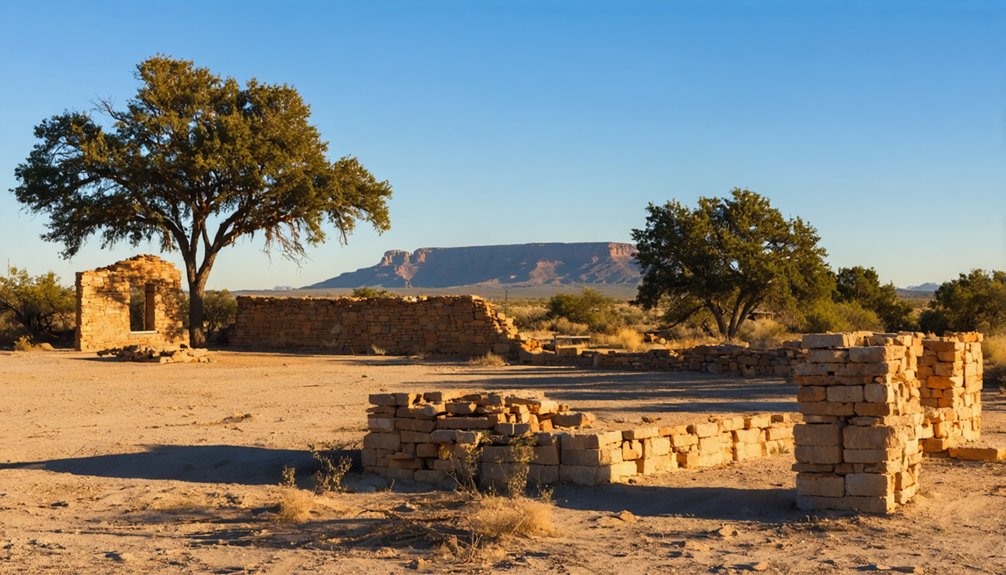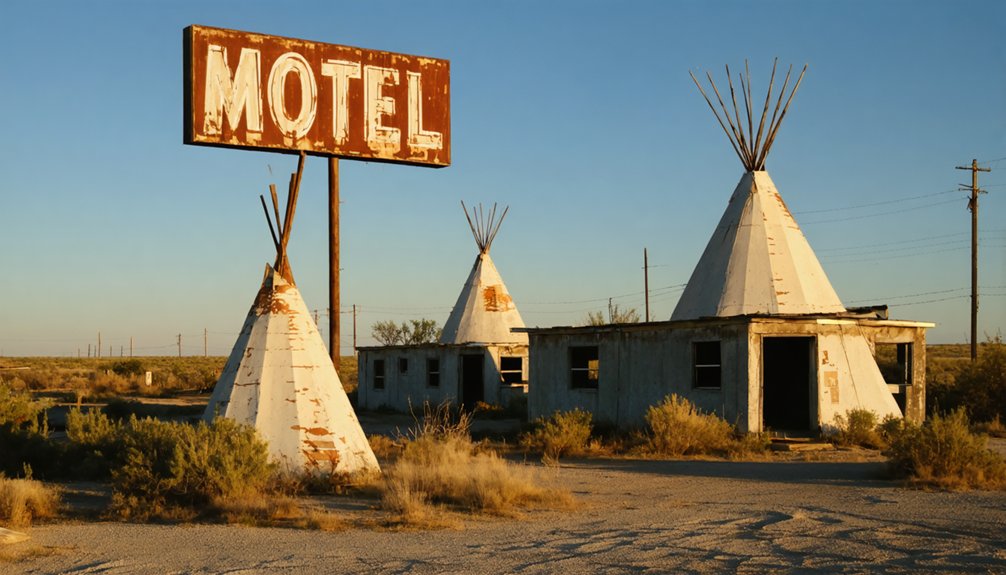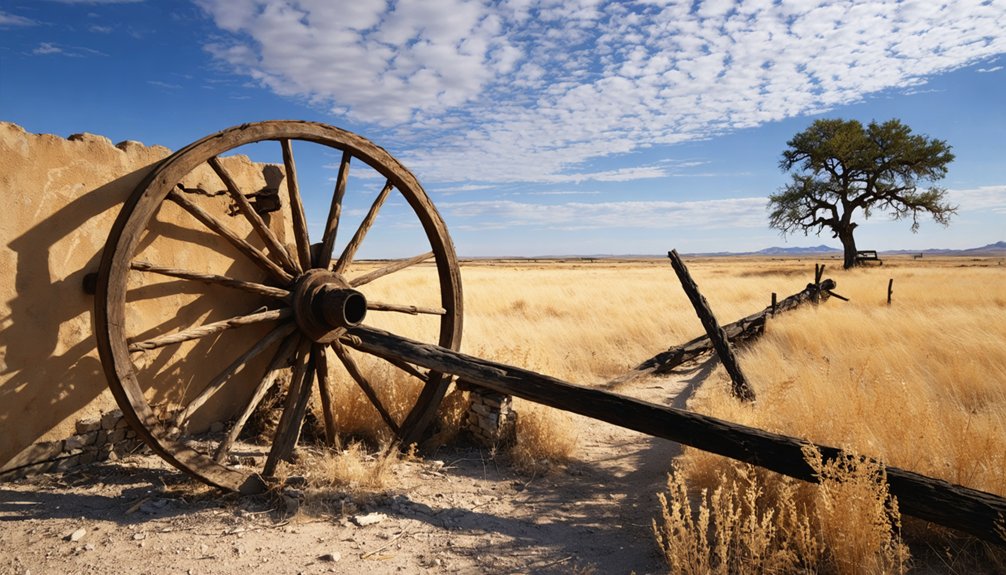You’ll find Tee Pee City‘s ruins in Motley County, Texas, where Charles Rath and Lee Reynolds established this frontier trading post in 1875. Named for the abandoned Comanche tipi poles settlers used for construction, it quickly became a bustling buffalo hunting hub near Tee Pee Creek. The town thrived with saloons, trading posts, and Texas Rangers until buffalo herds vanished in the late 1870s. By 1904, when the Matador Land and Cattle Company acquired the site, this once-vibrant frontier community held countless untold stories.
Key Takeaways
- Tee Pee City was established in 1875 near Motley County, Texas, using abandoned Comanche tipi poles for initial construction.
- The town flourished as a buffalo hunting and trading post between 1875-1878, with hunters processing up to 100 hides daily.
- The settlement featured S.N. Armstrong’s trading post, hotels, saloons, and served as Texas Rangers headquarters under Captain G. Arrington.
- Located at 2,165 feet elevation near Tee Pee Creek, the site is now marked by a 1936 Texas Centennial marker.
- The town’s decline began with buffalo extinction, and it officially closed in 1904 when acquired by Matador Land and Cattle Company.
The Birth of a Frontier Trading Post
As buffalo hunters and government surveyors pushed into the Texas Panhandle in 1875, frontier traders Charles Rath and Lee Reynolds established Tee Pee City as an essential trading post in Motley County.
You’ll find its origins tied to the resourceful early settlers who built their first structures using abandoned Comanche tipi poles found along Tee Pee Creek.
The settlement’s strategic location near the confluence of Middle Pease River and Tee Pee Creek made it ideal for frontier commerce.
Early inhabitants constructed basic picket houses and buffalo hide tents, creating a bustling hub where hunters, traders, and surveyors could find shelter and supplies.
The trading post’s position on the edge of Comanche hunting grounds connected Native American activity with the emerging settler economy, shaping the dynamic character of this frontier outpost.
The town quickly became a prosperous center for buffalo hide brokers, attracting traders from across the region.
The establishment later included a saloon and brothel that became notorious among local ranchers and travelers.
Buffalo Hunters and Hide Traders
The lucrative buffalo hide trade transformed Tee Pee City from a simple trading post into a thriving commercial hub between 1875 and 1878.
You’d find skilled hunting teams working the surrounding plains, with skinners processing up to 100 hides daily. During winter months, when buffalo coats were thickest, hunters pursued the most valuable prime hides for eastern hide markets. Sharps rifles enabled hunters to kill hundreds of buffalo each day. Experienced hunters like the Mooar brothers would target the herd leader first to disorient the group.
The trade wasn’t without its challenges. You’d face harsh weather conditions and dangerous confrontations with Indigenous warriors until Colonel Mackenzie’s military campaigns pushed tribes onto reservations.
Hunters sorted their bounty into distinct categories – bull, cow, robe, and kip hides – each commanding different market prices.
When hide prices eventually dropped, many hunters shifted to meat harvesting or abandoned the buffalo trade altogether, seeking new opportunities in ranching.
Life in Early Tee Pee City
Founded in 1875 at the meeting point of Tee Pee Creek and Middle Pease River, Tee Pee City emerged from humble beginnings as a frontier trading post.
You’d find yourself among a diverse mix of buffalo hunters, traders, surveyors, and Texas Rangers, all contributing to the town’s unique community dynamics. Life centered around S.N. Armstrong’s trading post, which included a hotel and saloon, while the town soon added gambling halls and a dance hall to serve its transient lifestyle. The town served as the Texas Rangers headquarters under Captain G. Arrington. Charles Rath and Lee Reynolds supplied the trading post with goods from Dodge City.
You’d likely have lived in a hide tent or wooden picket house, rubbing shoulders with both decent families and rough characters. While some residents, like the Cooper family who’d the county’s first white child, tried to establish roots, many found the lawless atmosphere too challenging and moved on.
Native American Heritage and Settler Culture
You’ll find Tee Pee City‘s origins in the abandoned Comanche campgrounds along Tee Pee Creek, where discarded chinaberry teepee poles marked their former presence.
When settlers arrived in 1875, they pragmatically repurposed these poles to construct their own picket houses, though the Comanches had already moved on from the area.
By 1877, the growing settlement supported two bustling saloons and a dance hall, marking its evolution into a rough frontier town.
The site’s transformation from Native American gathering place to frontier settlement happened quickly, with no documented cultural exchange between the groups beyond the settlers’ reuse of abandoned materials. Charles Rath and Reynolds established the site as a buffalo hunting camp that would soon attract the first dozen pioneer families to Motley County.
Comanche Campsite Origins
Before settlers established Tee Pee City in 1875, this location at the confluence of Tee Pee Creek and the middle fork of the Pease River served as an essential seasonal campsite for Comanche bands.
You’ll find evidence of Comanche traditions in the natural features they sought: clear creek water, native pecan trees, and abundant flint for toolmaking. These resources supported their nomadic lifestyle as they followed buffalo migrations across the plains.
The site’s strategic position made it ideal for buffalo hunting, a cornerstone of Comanche life and economy. When buffalo hunter camps arrived, they recognized the same advantages that had drawn the Comanche to this location.
They’d leave behind teepee poles when moving camp, marking their presence on the land. The area’s importance to the Comanche people extended beyond mere survival – it represented their deep connection to the land and their traditional way of life.
Frontier Cultural Exchange
While Comanche bands originally defined the area’s cultural landscape, the 1820s brought complex interactions between Native American tribes and incoming settlers near what would become Tee Pee City.
You’ll find that Cherokee, Shawnee, and Choctaw leaders engaged in cultural diplomacy, seeking Spanish and Mexican permission to settle in East Texas as a buffer against American expansion.
Native communities demonstrated remarkable agricultural adaptation, blending traditional practices with European farming methods while maintaining their cultural autonomy.
The local tribes established extensive trade networks, facilitating commerce and cultural exchange between various indigenous groups and European settlers.
Chiefs like Bowl and Fields negotiated with Mexican authorities for land rights, while settler leaders attempted to forge alliances with tribes.
Though treaties promised protection of Native territories, these agreements often went unfulfilled.
The frontier became a place of uneasy coexistence, where both settlers and tribes navigated shifting political allegiances and cultural boundaries.
Notable Landmarks and Geography

Three distinct natural landmarks define Tee Pee City‘s geographic setting: Tee Pee Creek, the Middle Fork of the Pease River, and the surrounding Texas Panhandle landscape.
You’ll find this ghost town‘s geographical features at an elevation of 2,165 feet, positioned near the confluence of these waterways. Its landmark significance is marked by a 1936 Texas Centennial marker, standing 10 miles east of Matador along U.S. Highway 70.
The site’s terrain once supported vast buffalo herds and provided natural building materials, including Chinaberry trees.
Today, you can explore the small cemetery west of the marker, just beyond a fence line. While most structures have vanished, the location’s strategic position between Fort Griffin, Fort Elliott, and Henrietta reveals its historical importance as a frontier outpost.
The Post Office and School Years
You’ll find that Tee Pee City’s civic development began in 1879 when A.B. Cooper established the town’s first post office, providing essential mail service to the remote Texas Panhandle community.
The arrival of formal education came in 1895 with the opening of one of Motley County’s first schools, marking the settlement’s evolution from a rough frontier outpost to a more structured community.
Both institutions served as anchors for local families until their respective closures in 1900 and 1902, just before the Matador Land and Cattle Company acquired the site in 1904.
Educational Hub Until 1902
In 1895, Tee Pee City established its first school, marking a significant milestone in the town’s brief but vibrant history. The educational impact extended beyond basic learning, as the school helped create community stability during the settlement’s peak years.
You’d find children of buffalo hunters, traders, and ranching families attending classes in a modest two-room building made from Chinaberry poles and mud plaster.
The school’s presence offered families a sense of permanence, operating alongside the post office, saloon, and general store.
However, as buffalo herds diminished and settlers moved away, student numbers dwindled. By 1902, with only a few families remaining (notably the Coopers), the school closed its doors.
This closure signaled the beginning of Tee Pee City’s ultimate decline.
Mail Service Pioneer Days
When A.B. Cooper established Tee Pee City’s first post office in 1879, you’d have found one of the earliest mail routes in the Texas Panhandle taking shape.
Cooper didn’t just run the postal service; he operated a general store and managed supply freight operations, making the post office a crucial hub for the region’s commerce and communication.
The postal history of this frontier town spans two decades, with the post office serving as an indispensable link between isolated settlers and the outside world until 1900.
Working alongside Cooper, Isaac O. Armstrong helped strengthen the community’s infrastructure through his hotel and saloon enterprises.
Together, they transformed what began as a rough buffalo hunters’ camp into a recognized settlement, though the post office’s closure in 1900 marked the beginning of the town’s decline.
Decline and Abandonment

The rapid collapse of Tee Pee City began with the near extinction of buffalo herds in the late 1870s, devastating the town’s primary economic foundation.
Without buffalo trade, local merchants and saloons saw their business dry up, leading to severe economic decline.
You’d have witnessed escalating lawlessness issues as buffalo hunters, renegade Native Americans, and unruly cowboys engaged in frequent gunfights and debauchery, requiring Texas Rangers’ intervention.
The situation worsened when the railroad bypassed the town, and the powerful Matador Ranch began dominating the region.
By 1900, the post office closed, followed by the school in 1902 as families fled the volatile environment.
The final blow came in 1904 when the Matador Ranch purchased and deliberately closed Tee Pee City, viewing it as a negative influence on their cowboys.
Historical Legacy and Preservation Efforts
Despite its complete abandonment by 1904, Tee Pee City‘s historical significance earned official recognition through a Texas historical marker placed in 1936, which still stands at a roadside park 10 miles east of Matador.
Today, you’ll find evidence of this frontier settlement’s legacy preserved through:
Trace the enduring footprints of this frontier outpost through carefully preserved records and landmarks that tell its remarkable story.
- A small cemetery containing the graves of Isaac Armstrong and three other early settlers
- Detailed archival records documenting the town’s buffalo hide trading past
- Educational materials used by local historical societies
- The historical marker’s text highlighting the Texas Rangers’ presence under Captain G.W. Arrington
While preservation challenges have left few physical remnants by the 1980s, the site remains accessible to visitors, serving as a reflection of early frontier life and the region’s ranching heritage.
The marker and cemetery continue connecting modern explorers with Tee Pee City’s pioneering spirit.
Frequently Asked Questions
Are There Any Surviving Photographs of Tee Pee City From Its Active Years?
You won’t find surviving photographs from Tee Pee City’s active period in historical records or archival sources. The town’s visual history relies mainly on written accounts and historical markers.
What Happened to the Original Inhabitants After the Town Was Abandoned?
By 1904, 100% of inhabitants faced historical migration when Matador Land Company purchased the area. You’ll find they scattered to nearby towns, worked on ranches, or moved away, though their community legacy persists through descendants.
Were There Any Famous Outlaws or Lawmen Associated With Tee Pee City?
You won’t find famous outlaw legends or notable lawman tales here – except for Texas Ranger Captain G.W. Arrington’s unit, which maintained a temporary headquarters between 1879-1881.
Can Visitors Access the Original Town Site Today?
Precious pioneer paths persist as you can visit the town site via County Road 206, north of U.S. 70. You’ll find remnants near Tee Pee Creek, including a historical marker and nearby cemetery.
How Many People Lived in Tee Pee City During Its Peak Population?
You’ll find that peak demographics reached around 150 residents in 1892, during the town’s historical height when buffalo hunters, traders, and businessmen made this frontier settlement their temporary home.
References
- https://en.wikipedia.org/wiki/Tee_Pee_City
- https://www.historictexas.net/city/tee-pee-city-texas
- https://www.davidroseministries.com/single-post/god-texas-tee-pee-city
- https://www.ghosttowns.com/states/tx/teepeecity.html
- https://atlas.thc.texas.gov/Details/5345012939
- https://kids.kiddle.co/Tee_Pee_City
- https://www.hmdb.org/m.asp?m=104861
- https://tfsdev.tamu.edu/websites/FamousTreesOfTexas/TreeLayout.aspx?pageid=16144
- https://www.texasescapes.com/TexasPanhandleTowns/Tee-Pee-City-Texas.htm
- https://freedomanwhisky.com/blogs/news/tee-pee-city-the-last-round-up



